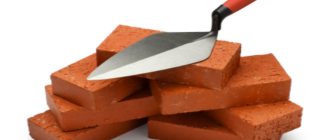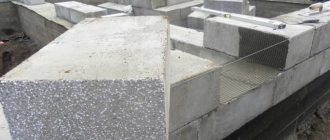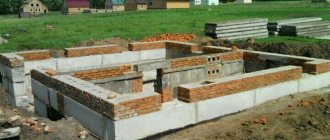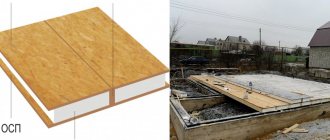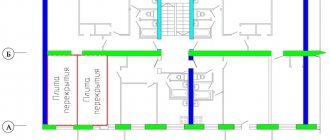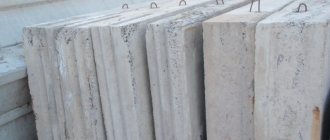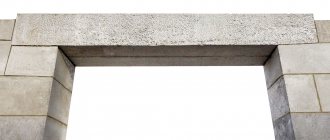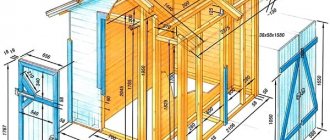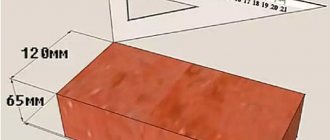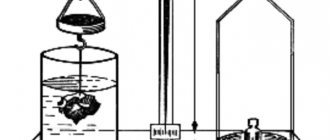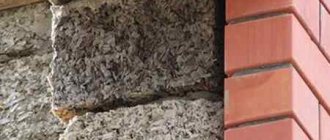Today the market is almost oversaturated with all kinds of building materials with different characteristics, properties and prices. Prominent representatives of cellular concrete are expanded clay concrete and gas silicate. Blocks made from these materials are lightweight, making buildings erected much faster. However, before buying building materials, it is worth figuring out what is better – gas silicate or expanded clay concrete. First of all, let's look at their properties.
Expanded clay concrete blocks technical characteristics
These blocks are made on the basis of the well-known expanded clay, which is added to the concrete solution. The composition contains both coarse expanded clay and expanded clay sand. Depending on the size of the filler, the strength of the blocks and their thermal insulation characteristics depend. Everyone knows that expanded clay is used as insulation. Accordingly, the properties of expanded clay blocks include a high rate of heat conservation.
Let's start with the standard sizes of expanded clay blocks. In fact, the sizes can be different, depending on your needs and goals. But the following values are considered standard:
- 188×190×390 mm;
- 188×90×390 mm.
The maximum permissible deviation from the standard is 10–12 mm. The first type of blocks are products for masonry walls, the second - for partitions. If we take into account the quality of the surface of the side face, then expanded clay concrete is divided into ordinary and front. Ordinary blocks are used to construct a box that will be protected by finishing. And the front ones are used to build clean walls, without additional finishing.
Note! One expanded clay concrete block can accommodate from 3 to 7 simple bricks.
In addition, the products are produced solid and hollow. Thanks to the voids, the block weighs even less, and its energy savings are much higher. But solid products are more reliable and heavier. They are used to build permanent walls that are subject to heavy loads.
Aerated concrete block
Aerated concrete block. This is probably the most successful compromise between the strength of a brick and the thermal conductivity of a foam block, and at the same time a very environmentally friendly option (in terms of strength, it is at the level of an expanded clay concrete block). Houses made from this material are distinguished by their lightness (less load on the foundation - you can save money) and good thermal characteristics. But at the same time, the price of an aerated concrete block is higher than that of a foam block and expanded clay concrete block; this is perhaps its only drawback. Recently, monolithic construction has been very popular. All these materials - brick, expanded clay concrete block, foam block, aerated concrete block - have their pros and cons, so you need to choose based on your requirements for the budget and the design of the walls of the house.
Additional information
- The density of expanded clay concrete blocks depends on the filler and its fraction. The range is quite large - 500–1800 kg/m3. Such indicators inspire confidence.
- The strength of expanded clay concrete blocks is also high - 35–250 kg/cm2, and this is an indicator from B3.5 to B20.
- Weight – 5–35 kg/piece.
- Service life - more than 60 years.
- Energy saving is a very important parameter. Due to the presence of expanded clay in the composition, the thermal conductivity of the material is low. The lower the density, the better the energy savings. This can be seen in the table below.
- Frost resistance affects the service life of products and the load-bearing capacity of the wall. Expanded clay concrete blocks have several indicators of frost resistance. The brand indicates the exact number of freeze and defrost cycles of the block. These are: F25, F35, F50, F75.
- The fire safety of the material is ideal. It simply does not burn, therefore it has a fire safety class of A1. Even under the influence of open fire, the walls will not collapse for as long as 7 or 10 hours.
- Vapor permeability is high, as expanded clay “breathes”. This creates an ideal indoor microclimate.
Characteristics of materials (composition of blocks)
The different physical and mechanical properties of concrete stone are determined by its composition and manufacturing technology.
| Block composition | |
| Expanded clay concrete | Aerated concrete |
| Portland cement | Portland cement |
| Quartz sand | Quartz sand |
| Expanded clay (agloporite) | Lime or fly ash |
| Water | Aluminum paste or powder |
| Modifying additives | Caustic soda |
| — | Water |
Expert opinion Vitaly Kudryashov builder, aspiring author
Ask a Question
Note: The quantitative composition of the ingredients depends on the given brand of product. For example, in expanded clay concrete, the water-cement ratio and the fraction of coarse filler can be changed to increase density.
Characteristics of gas silicate blocks
The material also has a porous structure. The production uses a silicate mixture and aluminum powder. Due to the reaction between the components, foam is obtained, which is processed in an autoclave. Due to this processing, the material becomes durable. The composition includes only environmentally friendly components, such as gypsum, simple sand and cement with water. Everything is mixed and filled with aluminum powder.
The dimensions of gas silicate blocks may vary. It all depends on the manufacturer. On the counters you can find the main dimensions: 600×100×300 mm; 250×400×600 mm; 600×200×300 mm; 500×200×300 mm. But the weight depends on the density and size indicators. It ranges from 5 to 40 kg.
Due to their structure, the blocks are quite easy to process. You can make grooves in them and cut them into any shape. It is an effective material used in construction.
Brick vs ceramic block: which is better?
Many users are faced with the problem of choice and do not know which is better, brick or ceramic block. Experts establish the following differences between these building materials:
- Brick has higher strength parameters, which makes it possible to use it for the construction of any structures.
- Thanks to the large dimensions of the ceramic block, the masonry is fast, reducing construction time by 3 times, and the user will also avoid multi-layer masonry, since the wall made of the ceramic block has a thickness of 510 mm.
- Brick is produced in several variations - masonry, facing, etc. Additional finishing of the facade is not required, unlike structures made of ceramic blocks.
- The blocks have a porous structure and voids, which allows for increased sound insulation performance. However, during installation you may encounter the problem of drilling holes, which can negatively affect the design of the block.
Gas silicate blocks and bricks: comparative characteristics
When answering the question of which is better, gas silicate blocks or bricks, you need to take into account some points:
- Gas silicate has less mass compared to brick. This allows you to reduce the load on the foundation, and transportation is carried out faster and with minimal costs.
- The thermal conductivity of gas silicate is 1.5 times less than that of brick. Experts talk about the following figures for heat conservation - brickwork 1.5 m thick corresponds to a standard wall made of gas silicate blocks 0.5 m thick.
- Thanks to the design features, brick retains heat much better.
- In terms of strength indicators, brick is significantly superior to gas silicate blocks.
Aerated concrete blocks or bricks
Analyzing the differences between brick and aerated concrete, several fundamental conclusions can be drawn:
- aerated concrete is not suitable for the construction of load-bearing structures, as it has the ability to withstand a load of 25-50 kg per 1 sq. cm (versus 110-2220 kg for brick);
- to obtain normal thermal insulation, the thickness of the brickwork must be at least 60 cm, while aerated concrete masonry perfectly maintains heat at a thickness of 40 cm;
- Due to its porous structure, aerated concrete is susceptible to high humidity and low temperatures. It is able to withstand temperature changes up to 30 cycles, while brick - up to 50;
- Aerated concrete has good moisture absorption, which can cause damage to the structure and the formation of mold and fungal microorganisms. To avoid this, you will have to incur additional costs for finishing the walls with waterproofing agents;
- the blocks have less mass, which affects the weight of the structure. With the same dimensions of the building, the total weight of a building made of aerated concrete is 6 times lower than that of brickwork.
Expanded clay and brick
Comparing which is better, brick or expanded clay blocks for construction allows us to draw the following conclusions:
- Expanded clay construction is not subject to subsequent shrinkage, while brickwork deforms over time, which causes cracks to appear.
- The level of water absorption of brick and expanded clay is approximately the same. Both materials do not absorb excess moisture, and pockets of mold and fungi rarely form on them.
- The block has a small mass with fairly noticeable dimensions. As a result, masonry goes much faster, and there are no additional costs or complications during transportation.
- Due to the design features of expanded clay, the level of sound insulation of the material is noticeably lower than that of brick.
- An expanded clay building requires additional finishing work, while standard brickwork has a rather attractive appearance without finishing.
Expanded clay concrete block or brick: which is better?
Comparing buildings made of expanded clay concrete blocks and bricks, we can talk about the following functional differences:
- the large dimensions of the blocks make it possible to reduce the time for construction;
- The level of vapor permeability for both options is approximately equal. This allows for the creation of an acceptable indoor microclimate;
- expanded clay concrete has an unattractive appearance, therefore, upon completion of construction, additional costs will be required for cladding the building, siding, etc.;
- both options have excellent environmental performance and are not exposed to open sources of fire;
- expanded clay concrete is characterized by very low thermal conductivity;
- brick has the ability to maintain natural air exchange, while expanded clay concrete does not have this parameter due to its porous structure.
On the website of the online store “Build with us-Kosulino” you will find a large catalog of bricks and building blocks at an optimally low price. By contacting our managers by telephone or by email, each consumer will receive information support and will be able to learn about the advantages and disadvantages of a particular type of building material.
Blocks with improved thermal insulation properties are used in the construction of residential and commercial buildings. There are several options for producing such materials. Let's try to help you decide on your choice: expanded clay concrete blocks or gas silicate blocks - which is better?
Additional information
- The density of gas silicate blocks is from D400 to D700, that is, from 350 to 900 kg/m3.
- The strength of gas silicate blocks is from 10 to 50 kg/cm2 (B0.75–B3.5 and higher).
- Weight – 5–40 kg/piece.
- Service life – from 50 years.
- Energy saving – 0.15-0.3 W/mS.
- Frost resistance – F25–F75.
- Fire safety - does not burn.
- Vapor permeability – 0.26–0.16 mg/m h Pa.
Now that you know the characteristics of both materials, you can compare them and choose the best one. Let's look at the positive and negative aspects of the products.
House made of expanded clay concrete
Today, expanded clay concrete is famous for the fact that no other material can so successfully combine the best characteristics of autoclaved aerated concrete blocks and ceramic bricks, as expanded clay blocks do. Expanded clay concrete blocks are building wall blocks created from lightweight concrete and filled with expanded clay. In turn, expanded clay, like foamed clay, is a very good insulation material. Therefore, expanded clay concrete walls make the house surprisingly warm and cozy.
Houses made of expanded clay concrete are distinguished by the use of environmentally friendly material, which is used without any chemical or harmful impurities: the composition of expanded clay blocks is absolutely safe for humans. This characteristic of the material and excellent reviews of its use served as the impetus for the fact that since the 90s of the last century it has been actively used in the building materials market here in Russia. Moreover, in our country, craftsmen even in the home have learned to make high-quality expanded clay concrete with their own hands.
The scope of application of such building blocks is very diverse. If previously houses were mainly built from expanded clay concrete, today this material is widely used in the construction of shopping centers, administrative buildings, warehouse and industrial buildings.
Also, expanded clay concrete blocks are very well suited for the construction of not only permanent buildings, but also small utility structures. Laying expanded clay concrete blocks is not difficult for professional masons: in principle, it is no different from laying foam concrete, ceramic bricks or brick blocks.
After reading this information, you may have already decided what kind of house you want to build: a house made of ceramic blocks or a house made of expanded clay concrete. In any case, we advise you to think carefully and come to the most informed decision.
Expanded clay concrete blocks
Advantages:
- They have excellent thermal conductivity. The buildings will be warm.
- They have sound insulation properties, much better than gas silicate.
- They have low cost. But the price-quality ratio is at the highest level.
- It has greater density and strength than gas silicate.
- High frost resistance, thanks to which the material lasts longer.
- It is moisture resistant and requires no maintenance. The material is not afraid of weather conditions.
- Has a low specific gravity.
- Ecologically pure.
- Due to good vapor permeability, the walls will breathe.
- After construction it does not shrink.
Flaws:
- Since the structure of the material is porous, the blocks themselves can be called fragile.
- If we take into account the same characteristics of the products, then the thermal insulation properties of expanded clay concrete are worse.
- The material does not have clear and perfectly even shapes.
Otherwise, this is an excellent building material that has proven itself only from the best side.
Expanded clay block or brick, which is better?
The question often arises: what is better suited for the wall construction of your future building: brick or expanded clay concrete block.
Let's consider the advantages and comparative characteristics of each building material, which have their own advantages and disadvantages. The scope of application depends on their characteristics. Expanded clay concrete blocks are a building material used for the construction of walls (foundations), containing cement, sand, and expanded clay. It can be full-bodied or empty. Brick is a building material consisting of clay and sand. Like expanded clay concrete blocks, they are used in the construction of load-bearing walls, partitions, and openings.
Specific gravity is a physical quantity that determines the ratio of the weight of a substance to its occupied volume. Expanded clay concrete blocks have a specific gravity 2.5 times lower than brick, which causes a small load on the foundation.
The volume of one expanded clay concrete block is approximately equal to the volume of 7 bricks. This will help save you construction costs (reduce the time required to complete the work, reduce the cost of delivery). Also, expanded clay concrete blocks do not shrink during laying. This helps to avoid the appearance of cracks on the walls and changes in the geometry of the walls subsequently.
Expanded clay concrete blocks are an environmentally friendly product with a low price. Due to the fact that the specific gravity of an expanded clay concrete block is lower than that of a brick, less cement will be needed when laying the blocks. Brick has a high cost and consumption of masonry material.
Brick and expanded clay concrete blocks have high strength and frost resistance. They tolerate temperature changes well and are resistant to atmospheric weather. Due to the low level of water absorption of expanded clay concrete blocks and bricks, they do not require maintenance and can be used as a facing material.
Comparative characteristics of the properties of expanded clay concrete block and brick:
Expanded clay concrete blocks are a highly porous building material consisting of natural materials: sand, expanded clay (burnt clay) and cement.
Due to their distinctive properties, these expanded clay blocks are successfully used for thermal insulation of buildings of any number of storeys, as well as in the construction of load-bearing and internal walls of residential and commercial buildings, in this regard providing significant competition to traditional brick and reinforced concrete slabs.
Advantages and disadvantages of building bricks
Advantages: • high mechanical strength, allowing the use of brick as the main material in high-rise and industrial construction with critical load values; • absolute fire safety; • environmental and antiseptic cleanliness; • invulnerability to atmospheric and negative chemical influences; • long service life.
Negative qualities: • relatively high price; • insufficient level of thermal insulation; • low quality of sound absorption; • poor waterproofing; • the possibility of mechanical fracture due to impact.
Gas silicate blocks
As always, let's start with the advantages of this material:
- Ideal dimensions, precision and light weight. The work is done quickly and easily.
- It is possible to do the laying not with mortar, but with special glue.
- Excellent heat saving performance.
- Due to the size, weight, ridges, grips and grooves, working with the material is comfortable. It can be cut, sanded, grooved and transported without much effort.
- Since the structure of the material is porous, the walls will “breathe”.
- Ecological cleanliness. There are no toxins that can harm the body.
Note! Due to the low density and good thermal insulation properties of gas silicate, the weight of the wall structure can be reduced. For example, comparing a gas silicate wall and a brick wall, the first one will be 3 times lighter. And compared to expanded clay concrete - 1.7 times.
Disadvantages of gas silicate blocks:
- The material is fragile.
- It absorbs moisture very strongly, so it needs to be protected.
- Has low compressive strength.
- Frost resistance is lower.
- After construction, the material shrinks.
- High price.
If you visually look at the indicators of expanded clay concrete and gas silicate, then the number of points in the first and second groups becomes immediately noticeable. Expanded clay concrete has 10 positive aspects but only 3 negative ones. And if we talk about gas silicate, then for 6 advantages there are as many as 6 disadvantages. The numbers speak for themselves. Still, a reasonable decision should be yours.
Advantages and disadvantages of gas silicate
Speaking about gas silicate, we can confidently highlight the following advantages of this material:
- Low specific gravity.
- Unlike expanded clay concrete, this material does not require additional processing, due to which construction time is halved.
- High thermal insulation properties. Single-layer structures can be erected from GS without fear that they will be cold.
- Gas silicate can be laid using glue, which reduces the thickness of the seam (2 mm). Expanded clay concrete is laid only on a cement-sand mixture, and the minimum seam height is 10 mm.
- Easy to grind and cut.
- Has good vapor permeability.
- Smooth and even blocks with correct geometry.
Among the disadvantages of gas silicate, the following disadvantages are distinguished:
- Fragility. Due to its low strength, cracks form in the plaster quite quickly. Therefore, gas silicate is rarely used for the construction of load-bearing walls.
- High level of moisture absorption (100%).
- Low compressive strength.
- Low level of frost resistance.
- The inability to produce aerated concrete blocks at home, without specialized equipment.
- Flowability of walls. Without special fasteners, it is impossible to secure objects on a gas silicate wall. Of course, a nail will easily pierce the surface, but the hardware will not stick to it.
- Cannot be finished. It will be very difficult to apply decorative plaster or any other composition to a perfectly smooth surface.
Healthy! According to rumors, gas silicate is harmful to humans. Actually this is not true. During the processing of the material, its main component (lime) loses its negative properties.
